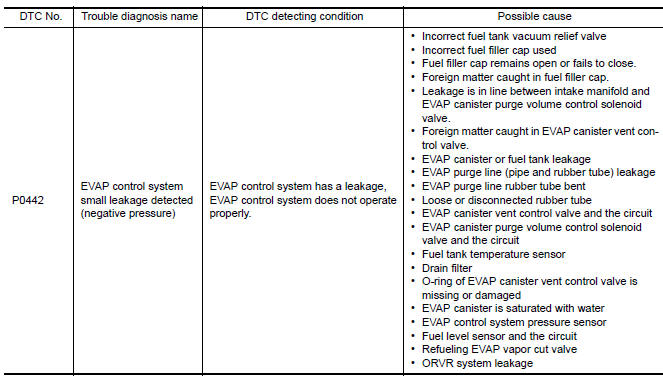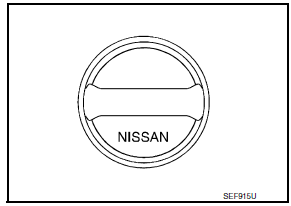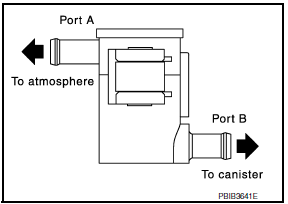Nissan Maxima Service and Repair Manual: P0442 evap control system
DTC Logic
DTC DETECTION LOGIC
This diagnosis detects leakage in the EVAP purge line using engine intake manifold vacuum.
If pressure does not increase, the ECM will check for leakage in the line between the fuel tank and EVAP canister purge volume control solenoid valve, under the following "Vacuum test" conditions.
The EVAP canister vent control valve is closed to shut the EVAP purge line off. The EVAP canister purge volume control solenoid valve will then be opened to depressurize the EVAP purge line using intake manifold vacuum. After this occurs, the EVAP canister purge volume control solenoid valve will be closed.


CAUTION:
- Use only a genuine NISSAN fuel filler cap as a replacement. If an incorrect fuel filler cap is used, the MIL may illuminate.
- If the fuel filler cap is not tightened properly, the MIL may illuminate.
- Use only a genuine NISSAN rubber tube as a replacement.
DTC CONFIRMATION PROCEDURE
1.PRECONDITIONING
If DTC Confirmation Procedure has been previously conducted, always perform the following before conducting the next test.
- Turn ignition switch OFF and wait at least 10 seconds.
- Turn ignition switch ON.
- Turn ignition switch OFF and wait at least 10 seconds.
TESTING CONDITION:
- Perform "DTC WORK SUPPORT" when the fuel level is between 1/4 and 3/4 full, and vehicle is placed on flat level surface.
- Always perform test at a temperature of 0 to 30C (32 to 86F).
NOTE: Check that EVAP hoses are connected to EVAP canister purge volume control solenoid valve properly.
2.PERFORM DTC CONFIRMATION PROCEDURE
With CONSULT
- Turn ignition switch ON.
- Turn ignition switch OFF and wait at least 10 seconds.
- Turn ignition switch ON and select "DATA MONITOR" mode with CONSULT.
- Check that the following conditions are met.
COOLAN TEMP/S: 0 - 70C (32 - 158F) INT/A TEMP SE: 0 - 30C (32 - 86F)
- Select "EVP V/S LEAK P0456/P1456" of "EVAPORATIVE SYSTEM" in "DTC
WORK SUPPORT" mode
with CONSULT.
Follow the instructions displayed.
NOTE: If the engine speed cannot be maintained within the range displayed on the CONSULT screen
3.PERFORM COMPONENT FUNCTION CHECK
With GST
NOTE: Be sure to read the explanation of EC-26, "SRT Set Driving Pattern" before driving vehicle.
- Start engine.
- Drive vehicle according to EC-26, "SRT Set Driving Pattern".
- Stop vehicle.
- Turn ignition switch OFF and wait at least 10 seconds.
- Turn ignition switch ON.
- Turn ignition switch OFF and wait at least 10 seconds.
- Turn ignition switch ON.
- Check 1st trip DTC.
Diagnosis Procedure
1.CHECK FUEL FILLER CAP DESIGN

- Turn ignition switch OFF
- Check for genuine NISSAN fuel filler cap design.
2.CHECK FUEL FILLER CAP INSTALLATION
Check that the cap is tightened properly by rotating the cap clockwise.
3.CHECK FUEL FILLER CAP FUNCTION
Check for air releasing sound while opening the fuel filler cap.
4.CHECK FUEL TANK VACUUM RELIEF VALVE
5.CHECK FOR EVAP LEAKAGE
6.CHECK DRAIN FILTER
7.CHECK EVAP CANISTER VENT CONTROL VALVE
Check the following.
- EVAP canister vent control valve is installed properly.
Refer to FL-16, "Removal and Installation".
- EVAP canister vent control valve.
8.CHECK IF EVAP CANISTER IS SATURATED WITH WATER

Remove EVAP canister with EVAP canister vent control valve and EVAP control system pressure sensor attached.
9.CHECK EVAP CANISTER
Weigh the EVAP canister with the EVAP canister vent control valve and EVAP control system pressure sensor attached.
The weight should be less than 2.1 kg (4.6 lb).
10.DETECT MALFUNCTIONING PART
Check the following.
- EVAP canister for damage
- EVAP hose between EVAP canister and drain filter for clogging or poor connection
11.CHECK EVAP CANISTER PURGE VOLUME CONTROL SOLENOID VALVE OPERATION
With CONSULT
- Disconnect vacuum hose from EVAP canister purge volume control solenoid valve at EVAP service port.
- Start engine.
- Perform "PURG VOL CONT/V" in "ACTIVE TEST" mode.
- Touch "Qu" on CONSULT screen to increase "PURG VOL CONT/V" opening to 100%.
- Check vacuum hose for vacuum.
Vacuum should exist.
12.CHECK EVAP CANISTER PURGE VOLUME CONTROL SOLENOID VALVE OPERATION
Without CONSULT
- Start engine and warm it up to normal operating temperature.
- Stop engine.
- Disconnect vacuum hose from EVAP canister purge volume control solenoid valve at EVAP service port.
- Start engine and let it idle for at least 80 seconds.
- Check vacuum hose for vacuum when revving engine up to 2,000 rpm.
Vacuum should exist.
13.CHECK VACUUM HOSE
Check vacuum hoses for clogging or disconnection.
14.CHECK EVAP CANISTER PURGE VOLUME CONTROL SOLENOID VALVE
15.CHECK FUEL TANK TEMPERATURE SENSOR
16.CHECK EVAP CONTROL SYSTEM PRESSURE SENSOR
17.CHECK EVAP PURGE LINE
Check EVAP purge line (pipe, rubber tube, fuel tank and EVAP canister) for cracks or improper connection.
18.CLEAN EVAP PURGE LINE
Clean EVAP purge line (pipe and rubber tube) using air blower.
19.CHECK EVAP/ORVR LINE
Check EVAP/ORVR line between EVAP canister and fuel tank for clogging, kinks, looseness and improper connection.
20.CHECK RECIRCULATION LINE
Check recirculation line between filler neck tube and fuel tank for clogging, kinks, cracks, looseness and improper connection.
21.CHECK REFUELING EVAP VAPOR CUT VALVE
22.CHECK FUEL LEVEL SENSOR
23.CHECK INTERMITTENT INCIDENT
Component Inspection
FUEL TANK VACUUM RELIEF VALVE (BUILT INTO FUEL FILLER CAP)
1.CHECK FUEL FILLER CAP

- Turn ignition switch OFF.
- Remove fuel filler cap. Refer to FL-10, "Exploded View".
- Wipe clean valve housing.
- Install fuel filler cap adapter (commercial service tool) to fuel filler cap.
- Check valve opening pressure and vacuum.

Pressure: 15.3 - 20.0 kPa (0.156 - 0.204 kg/cm2, 2.22 -
2.90 psi)
Vacuum: −6.0 to −3.3 kPa (−0.061 to −0.034 kg/cm2,
−0.87 to −0.48 psi)
2.REPLACE FUEL FILLER CAP
Replace fuel filler cap. Refer to FL-10, "Exploded View".
CAUTION: Use only a genuine fuel filler cap as a replacement. If an incorrect fuel filler cap is used, the MIL may illuminate.
DRAIN FILTER

- Check visually for insect nests in the drain filter air inlet.
- Check visually for cracks or flaws in the appearance.
- Check visually for cracks or flaws in the hose.
- Blow air into port A and check that it flows freely out of port B.
- Block port B.
- Blow air into port A and check that there is no leakage.
- If NG, replace drain filter.
 P0441 evap control system
P0441 evap control system
DTC Logic
DTC DETECTION LOGIC
NOTE:
If DTC P0441 is displayed with other DTC such as P2122, P2123, P2127, P2128 or
P2138, first perform
trouble diagnosis for other DTC.
In this evaporative em ...
 P0443 evap canister purge volume control solenoid valve
P0443 evap canister purge volume control solenoid valve
Description
The EVAP canister purge volume control solenoid valve is used to
control the flow rate of fuel vapor from the EVAP canister. The EVAP
canister purge volume control solenoid valve ...
Other materials:
System description
INTELLIGENT KEY SYSTEM/ENGINE START FUNCTION
System Diagram
System Description
INPUT/OUTPUT SIGNAL CHART
SYSTEM DESCRIPTION
The engine start function of Intelligent Key system is a system
that makes it possible to start and stop the
engine without removing the key. It verifies the ...
CVT fluid cooler system
Cleaning
Whenever an automatic transaxle is repaired, overhauled,
or replaced, the CVT fluid cooler mounted in the
radiator must be inspected and cleaned.
Metal debris and friction material, if present, can be trapped or be deposited
in the CVT fluid cooler. This
debris can contaminate t ...
Antenna AMP
Removal and Installation
REMOVAL
Remove the rear pillar finisher RH. Refer to INT-23, "Exploded
View".
Detach the antenna amp. harness clip (A).
Disconnect the harness connectors (B) from the antenna amp.
(1).
Remove the antenna amp. screw (C) and the antenna amp. (1).
INSTALLAT ...
Nissan Maxima Owners Manual
- Illustrated table of contents
- Safety-Seats, seat belts and supplemental restraint system
- Instruments and controls
- Pre-driving checks and adjustments
- Monitor, climate, audio, phone and voice recognition systems
- Starting and driving
- In case of emergency
- Appearance and care
- Do-it-yourself
- Maintenance and schedules
- Technical and consumer information
Nissan Maxima Service and Repair Manual
0.0061
